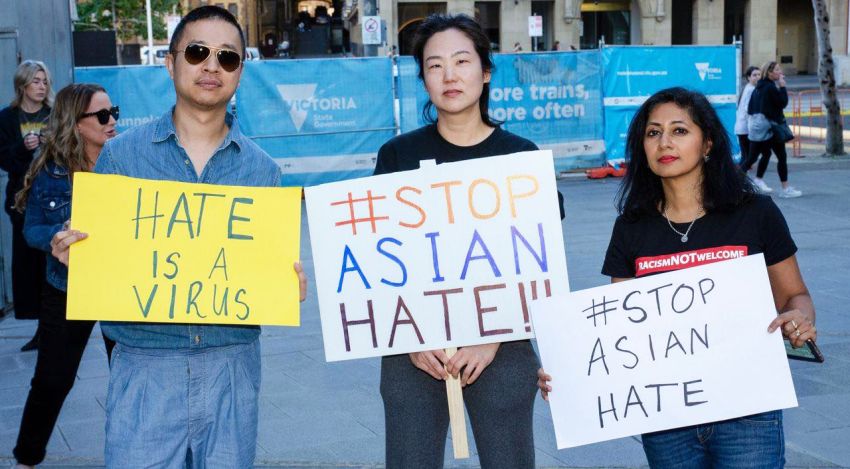
A second report on COVID-19 driven racism by the Asian Australian Alliance, in collaboration with Osmond Chiu, a researcher at the Per Capita think tank was released on July 22. It makes chilling reading.
The first incident report was based on 377 reports of COVID-19 related racism incidents over a two-month period. It was published in June last year, when Australia’s tit-for-tat trade war with China had begun and, as racist attacks on people of Asian background grew, China urged its citizens not to travel to Australia.
This year’s report is based on an additional 164 reports.
The researchers, part of the #STOPASIANHATE campaign, suggest federal and state pandemic policies are contributing to anti-China/Chinese people sentiment. The researchers said that Asians and other migrant communities were also blamed for community transmission in Victoria’s second wave in June last year.
The federal government’s harsh response to the Delta variant spike in India in late April — banning Indian-Australians from returning home and threatening them with fines and imprisonment if they found a way back through third countries — has also played its part in fuelling anti-Asian racism.
The latest pandemic outbreak in Sydney has generated a similarly draconian response from the federal and state governments: the South Western and Western suburbs — with their highly multicultural demographic — have been locked down for more than a month.
The researchers said it points to “a racial/ethnic focus of blame directed at a community for breaking lockdown rules rather than a deeper analysis of how a higher casualised workforce, larger households and ineffective public health campaigns targeting CALD [culturally and linguistically diverse] communities has led to the latest surge”.
The scapegoating of migrant communities has now shifted from Melbourne to Sydney, the report said, adding that the underlying racial focus of the blame is the same.
The over-policing of South West Sydney compared to the management in the more affluent Eastern suburbs (where the outbreak originated) promoted criticism from community leaders. As one local resident put it: “It’s that idea that we’re ethnics; we’re lawless. There’s never mediation, just enforcement.”
The researchers listed the types of incidents, their location and the trend. They found that nearly 36% of respondents had been subjected to direct name calling, or slurring, such as “Go back to China”, “Stop eating bats/dogs”, and “Ching Chong”.
Twenty-six per cent reported online harassment. Just over 13% said the racist tried to laugh it off a joke.
“Stopped at the traffic lights on a street. The car next to us, pulls down their car windows and screams out towards us ‘Coronavirus’, and all the car passengers were laughing non-stop.”
Nearly 8% said they were spat, sneezed or coughed on, 7% reported physical intimidation and 6.5% reported shunning — deliberate avoidance or exclusion.
“[An] 11-year-old kid walked by me in the street and told me to ‘F@#k off Asian whore, c@#t, go back to your own country’ and kicked me.”
“I was sending a package of gifts to my cousin who is about to have a baby. An older white couple was filling in a form at another counter. They looked at me, called me a disgusting virus, and then said ‘haven’t your lot sent enough of our stuff to China?’”
Just 2% reported the abuse at a work setting. Most of the racist incidents took place in a public setting, including 15% in a supermarket/grocery store/general stores and nearly 10% in public transport.
“I was standing outside of Aldi, waiting to be picked up from an appointment I had in a nearby building, when suddenly this girl who looked like she was in her late teens - early 20s started muttering something angrily as she walked towards me. When she walked past me she spat on the ground near me and glared at me. I looked up to her utterly confused and she looked me in the eye and yelled out aggressively: ‘Yeah, I spat on you, what are you going to do about it?’”
Those identifying as female were the largest number of respondents (60%), followed by those who identified as male (34%). Nearly 4% of respondents did not identify as being female or male.
In other trends, respondents who identified as having a Chinese cultural background (52%) reported more incidents than other races or ethnic groups. This was followed by Vietnamese (8 %), Malaysian (5%), Korean (7%), Singaporean (2%) and Filipino (3%).
Most (95%) of the international students who responded were of Mainland Chinese background. Close to 86% said they did not know the perpetrator. Most (85%) did not report the abuse to police or another authority.
[For further information or to receive a copy of this report email [email protected]. For more information visit Asian Australian Alliance.]